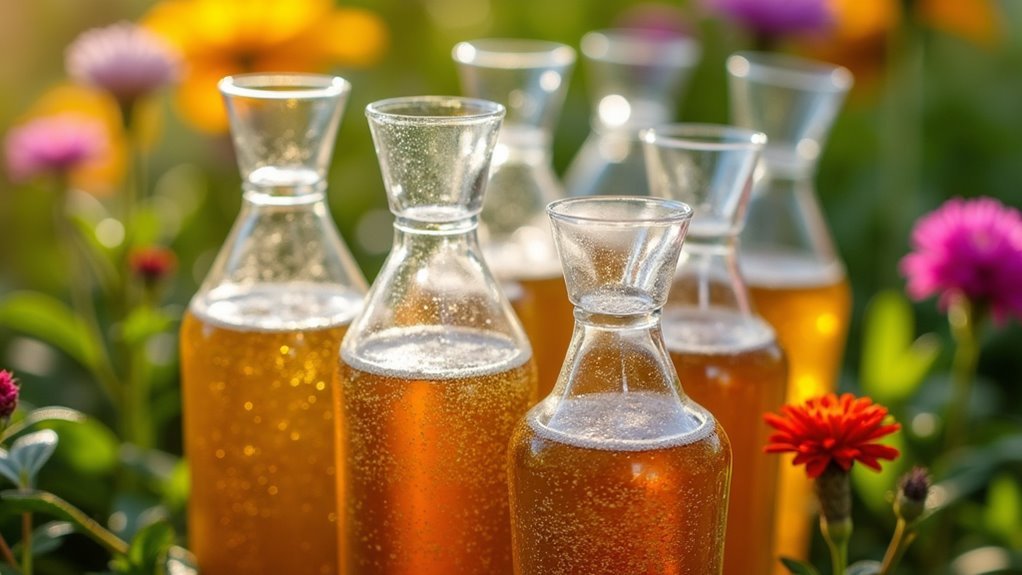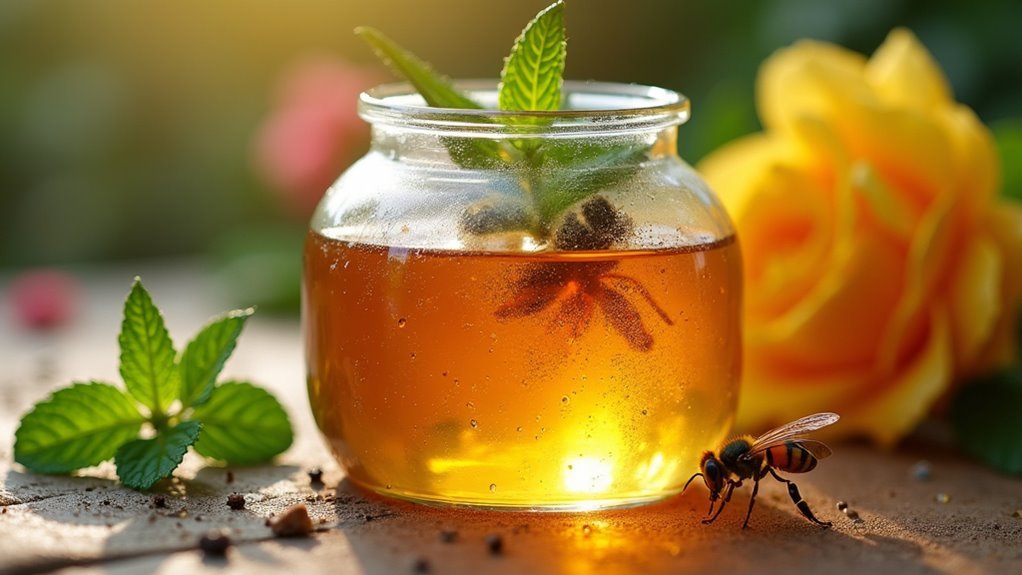You’ll create the perfect sugar water wasp trap by mixing four cups white sugar with two and a half cups water, heating until dissolved, then adding one tablespoon of vinegar to attract wasps while deterring bees. Use a 2-liter plastic bottle with the neck cut and inverted into the bottom, then hang it 1.5 meters high near fruit trees or garbage bins but 6-7 meters from dining areas. Follow these strategic placement and maintenance techniques to maximize your trap’s effectiveness.
Essential Materials for Building Your Sugar Water Trap

Building an effective sugar water wasp trap starts with gathering the right materials, most of which you’ll likely find around your home.
You’ll need a plastic bottle (preferably a 2-liter soda bottle), a sharp knife or box cutter for cutting, and white sugar plus water to create your best bait solution. This sugar water mixture serves as an irresistible food source that attracts wasps into your DIY wasp trap.
Additional helpful items include a funnel for mess-free pouring, a permanent marker to mark your cutting line, and wire or string if you’re planning to hang the trap.
For preparing the bait, grab a pot and wooden spoon to heat and dissolve the sugar completely.
This effective DIY approach uses simple household materials to create a powerful wasp control solution.
Creating the Perfect Sugar Water Bait Recipe
Now that you’ve assembled your materials, the next step focuses on mixing a bait that’ll draw wasps straight to your trap.
Create your sugar water by combining four cups of white sugar with two and a half cups of water. Heat this mixture until the sugar completely dissolves, then let it cool entirely.
Mix four cups white sugar with two and a half cups water, heat until dissolved, then cool completely.
Add one tablespoon of vinegar to keep wasps away from beneficial bees while maintaining wasp attraction.
Your DIY wasp trap needs enhanced appeal, so substitute or add fruit juice or soda to the sweet liquid mixture. Include ripe fruit chunks or local fruit flavoring for maximum effectiveness, especially during late summer when wasps crave sugary foods.
Replace your bait weekly to guarantee continued attraction.
Assembling the Bottle Trap Structure

Once you’ve prepared your sugar water bait, you’ll need to transform your plastic bottle into an effective trap structure.
Start by cutting the neck off your soda bottle just below the taper, making a clean, straight cut. Remove the cap and invert this top part, placing it inside the bottom of the bottle to create a funnel entrance. This design allows wasps to enter easily but prevents their escape, making it one of the most effective homemade wasp traps.
Secure the inverted neck with tape or glue to maintain stability. For hanging your trap, punch two holes near the rim.
Position the completed trap at least 1.5 meters above ground in high-activity areas.
Strategic Placement and Timing for Maximum Effectiveness
With your trap assembled and ready, where you place it determines whether you’ll catch dozens of wasps or waste your time with an empty bottle.
Strategic placement during summer and early fall maximizes your sugar water trap’s effectiveness when wasps actively hunt for food sources.
Position your traps strategically using these guidelines:
- Location targeting: Place near fruit trees or garbage bins where wasps naturally congregate
- Safe distance: Position 6-7 meters away from patios and outdoor dining areas
- Optimal height: Hang 1.5 meters above ground in trees for maximum visibility
- Seasonal timing: Deploy from March through October, with peak results in August-October
Monitor and maintain your traps weekly throughout the season.
Clean thoroughly and refresh the sugar water bait to sustain catching power when wasps need food most desperately.
Maintenance Tips to Keep Your Trap Working

While your sugar water trap sits outside doing its job, it requires consistent upkeep to maintain peak performance throughout the wasp season.
Check your bottle trap weekly to remove dead wasps and prevent any buildup that could reduce effectiveness. Replace the sugar water solution every week, particularly during late summer when wasps are most active.
Clean your bottle thoroughly before refilling to eliminate odors that might deter wasps from entering. These maintenance tips guarantee consistent trapping success.
Consider adding dish soap drops to your fresh solution—this prevents wasps from escaping once they land in the mixture. If your trap isn’t attracting wasps, relocate it closer to their activity areas while keeping it away from dining spaces.
Frequently Asked Questions
What Is the Best Liquid to Put in a Wasp Trap?
You’ll want to use sugar water made from four cups of sugar dissolved in two and a half cups of water. Add dish soap to prevent escapes and vinegar to deter bees.
What Is the Best Formula for a Wasp Trap?
You’ll want to mix two parts sugar with one part water, dissolving four cups sugar in two and a half cups water over medium heat, then add several drops of dish soap.
What Is the Ratio of Sugar to Water for Wasps?
You’ll want to use 2 parts sugar to 1 part water for your wasp trap. This strong concentration creates an irresistible attractant that’ll draw wasps effectively without being too diluted.
Why Does Dawn Dish Soap Kill Wasps?
Dawn dish soap kills wasps by breaking water’s surface tension, trapping them when they land. The soap coats their bodies, blocking their breathing holes called spiracles, which suffocates them quickly.
In Summary
You’ve now got everything you need to create an effective sugar water wasp trap. Remember, consistency is key – you’ll need to refresh your bait regularly and clean out captured wasps to maintain the trap’s effectiveness. Don’t get discouraged if results aren’t immediate; it often takes a few days for wasps to discover your trap. With proper placement, timing, and maintenance, you’ll greatly reduce wasp activity around your outdoor spaces.





Leave a Reply